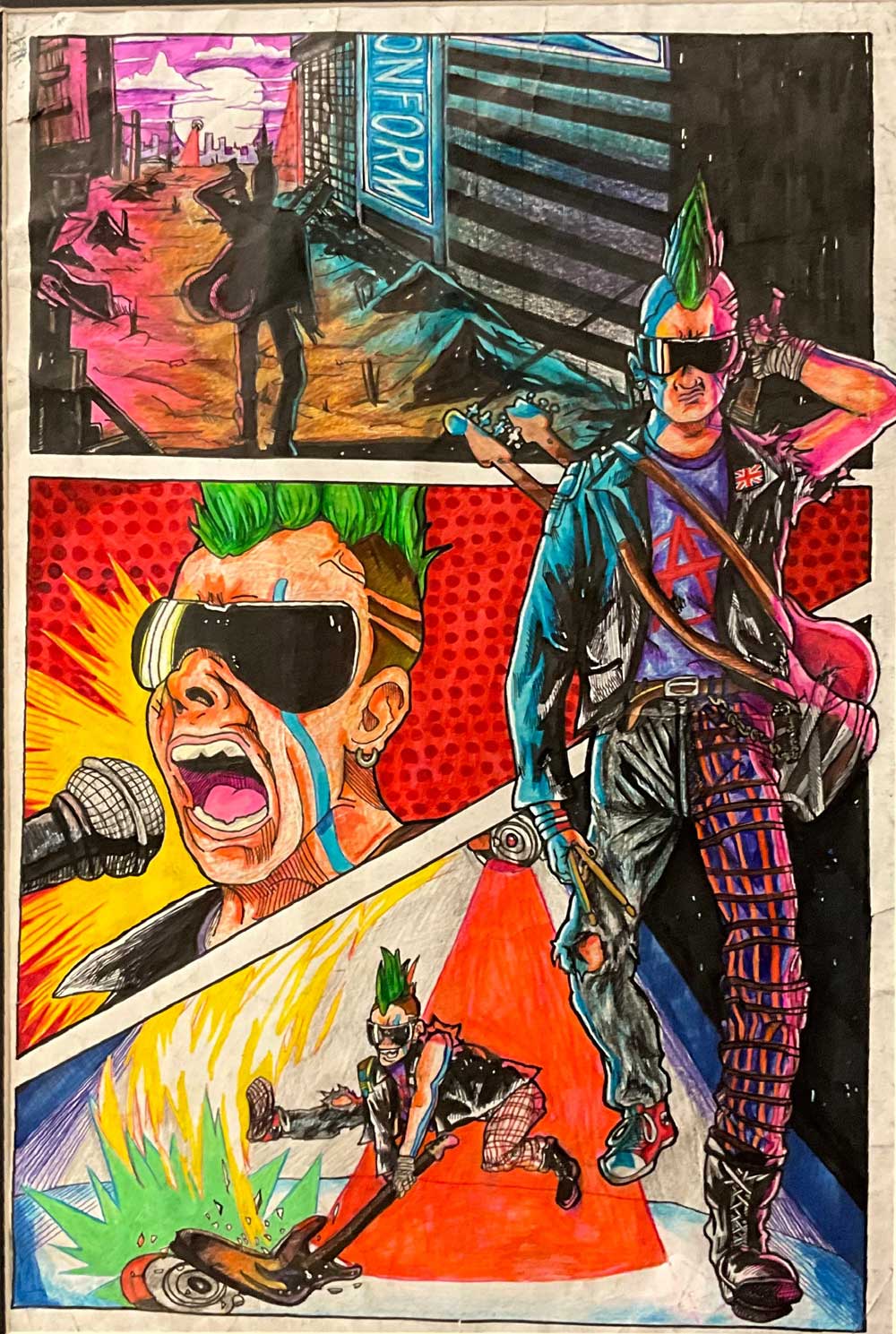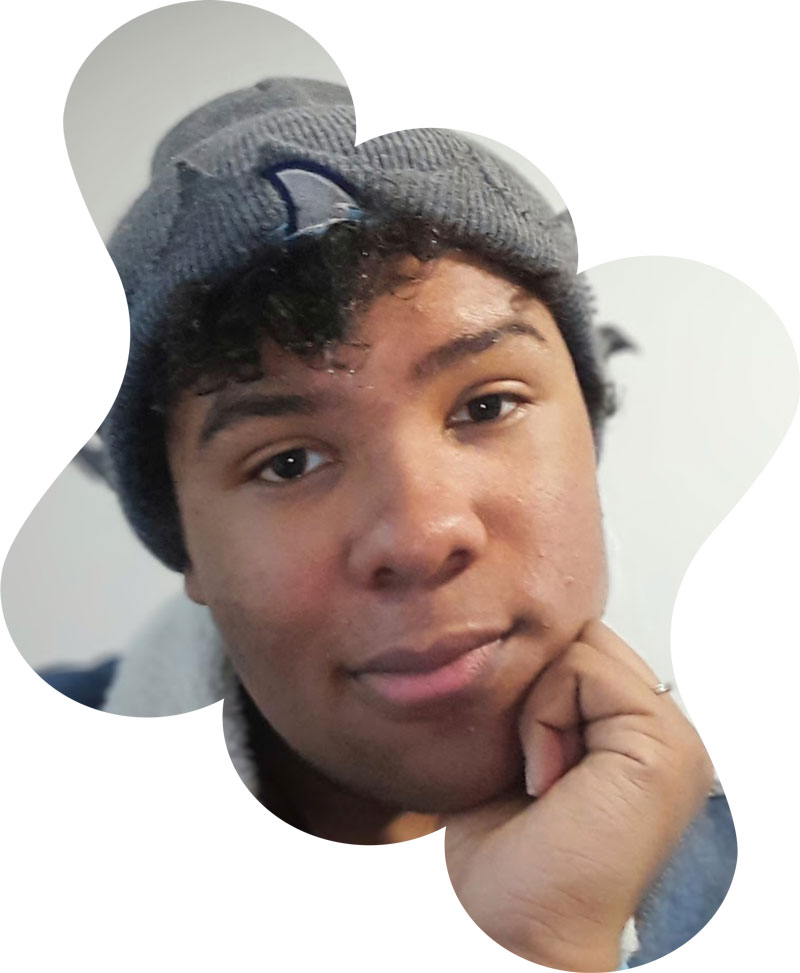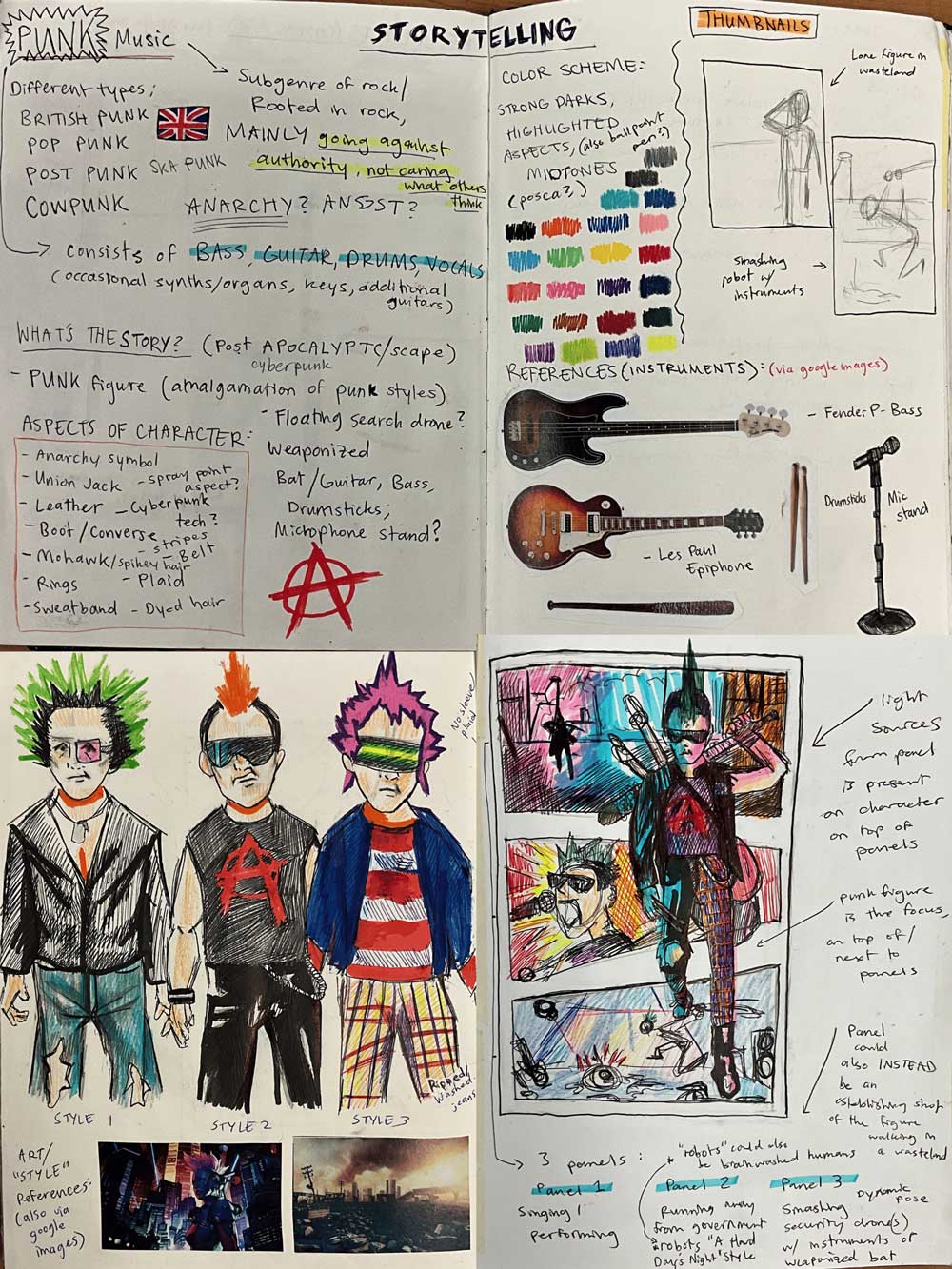

Tales of a Teenage Anarchist

Height: 18” x Width: 12” | Idea(s): Embodying punk culture & opposition of authority in a futuristic dystopia via a comic panel style | Material(s): Ballpoint pen, paint pen, alcohol marker, colored pencil, Copic Multiliner on drawing | Process(es): Emphasizing punk youth frustration in balanced composition; contrasting authority w/ punk youth | Citation(s): 70's punk styles on Google images, Bigstock, They Live (1988)
Curatorial Note: A well-researched and unique exploration of human emotion through music, using comic paneling to depict the narrative of punk music.
Daryl Price II


Student statement
Student statement
Does your work reference or draw on a contemporary or historical art-making style, practice, or tradition? If so, please explain.
It's comic book-esque, mostly inspired by the paneling/page work of Rob Liefeld, with a character on one side of the entire page and overlapping panels that mainly appear on the other side of that same page.
Please describe the context for how the idea for this artwork originated (was this part of your sustained investigation, an independent project, a class assignment, created during a summer study, etc.).
This work was part of my sustained investigation, and, as my SI was focused on different genres of music, this piece in particular was influenced by punk music as a whole—very anti-establishment and full of rebellion. To further that feeling, I combined it with vague references to a post-apocalyptic landscape and motifs from John Carpenter's They Live (1988).
In what ways did you practice and experiment when developing your sustained investigation?
I first practiced with different stylings of traditional, classic punk during its peak (the 1970s and 1980s), laying out different character designs with different color scheme experiments. I also figured out what instruments this character should hold, as having instruments in general would directly reference what most bands used during that time. Finally, I played around with potential thumbnails, just layouts of how I wanted the background environment to look and how everything (the panels and character) would look layered and colored.
How did you demonstrate revision in your sustained investigation?
Although my SI stayed pretty static (in a good way), constantly referencing back to that investigation helped me see that I didn't have to focus on "how different genres of music impact the human psyche" just within an analytical psychological lens, but also how they made communities as a whole feel, how they impacted ME and my emotions. I think doing that with this work especially helped it feel more personal and engaging for the viewer to look at and absorb.

By developing my skills in figure, creating space, and personalization and as I delved deeper into what my SI asked, I focused into exemplifying the emotion the genres rose out of me, peers, and the public BECAUSE of those symbols. After revision with this concept, I began to visually express how the message of the genre impacted emotions, or the "human psyche."

Idea(s): Embodying punk culture & opposition of authority in a futuristic dystopia via a comic panel style | Material(s): Ballpoint pen, alcohol marker, paint pen, & colored pencil on mixed- media paper |
Process(es): Practice with balance and composition to emphasize punk styling, assist in ultimately showing vexation | Citation(s): 70's punk styles on Google images, Bigstock, They Live (1988)
Your work was selected in part because it achieved synthesis. Can you explain your intentionality in choosing materials and developing processes to further your ideas?
I've always been a pretty mixed-media artist, but I think I really pushed myself with this piece by sort of limiting the materials I used. The final piece stayed pretty true to the thumbnail sketch that I made, in both layout and quick, almost sketchy mediums. With that, I mean the inking was made to be solid and fairly clean overall. The colors, however, were lower-quality colored pencils, hard ballpoint pens, fine-pointed paint pens, and even dry erase markers—all on a sort of beat-up sheet of drawing paper. I think the grittiness of these materials together helped evoke the raw intensity of punk music, and I just really love how it all worked out.
How did your art teacher support your artistic development?
Ms. Byrnes helped me establish an actual schedule to have works due. This was more than just a general assignment you'd work on in class for a month. It was actually having a set thumbnail/plan, (hopefully) finishing a final piece, and giving/accepting good peer critique all within two weeks in five to six 90-minute class periods. Learning how to effectively work within that schedule, with constant check-ins with her (when needed), assisted immensely in pushing myself to work with a stricter schedule, and I can confidently say it prepared me for college art classes as well. Additionally, she helped me think deeper about any ideas I had for thumbnails and general concepts, which I think made all of my pieces stronger.
How did your school leadership (principal, assistant principal, guidance counselor, etc.) support your growth as an art student? This could be classroom visits, attending art shows, talking to you about your goals, etc.
Dr. Healey, my principal at Colgan High School, was always supportive of the visual arts departments (considering it was a fine/performing arts school). I spoke with him one-on-one, proposing a senior mural design for the National Art Honor Society to paint, and he respected my readiness and preparedness. As president of NAHS, this was really good to hear and helped me continue to maintain discipline within having designs ready, and just overall keep taking pieces one mark at a time (aka, "all progress is good progress").
What is your advice to other AP Art and Design students?
My top advice to any AP art student is having a good thumbnail/starting idea for a final piece. Now I don't mean "good" as in objectively a beautiful piece or anything, but something that you KNOW can inspire a finished work. An effective thumbnail sketch, or even a written concept, will help you focus an idea you have in your head...on paper, canvas, whatever substrate you're working on. That idea is where your content lies, and a good thumbnail is how you can set the stage for a generic concept to turn into something more (directly) reflective of your SI and creative voice.
Elizabeth Byrnes
Art Teacher and Visual Arts Liaison
Charles J. Colgan Center for the Fine and Performing Arts, Manassas, VA, USA
Teacher statement
Teacher statement
The AP Art and Design course supports inquiry-based personalized learning in the sustained investigation portfolio component. What strategies helped you guide students through inquiry?
Each year I work diligently, one on one ,with each student to assist in finding and fostering their artistic voice. We work on developing a path for themselves, developing their sustained investigation question, how to demonstrate it and answer it visually. We work on things they love and relate to and are of interest to them directly. This allows them endless personal ideas and feelings to pull from over the year. We continue to meet and critique as a class to best support each student.
How did you scaffold writing into the art-making and thinking processes?
We work on the creative process, planning and writing artist statements for art they have created. Sketchbooks, reflection, and revision is to be documented in their sketchbook throughout their AP year. They are brainstorming and rewriting, and I encourage "Word work." This is an activity where a student writes anything and everything within their stream of consciousness. This helps to stimulate their ideas, experimentation, and potential artwork. It most often gives them mental images and ideas on a direction to go to next.
How did you support skill development AND inquiry in the AP Art and Design curriculum?
Our specialized art program offers master-class opportunities where students can participate in extended art enrichment activities to learn skills and try new ways to use these. We host professional artists, alumni, and collaborations to broaden student skill development. Fostering inquiry, I draw parallels similar to writing an essay or academic seminar participation. I then discuss how to develop similarly, creating artwork as a visual answer. Research, experimentation, and process of development result in a finished sustained investigation "visual essay" by them.
How did you structure practice, experimentation, and revision into your AP Art and Design curriculum?
I take students on a mini field trip to our art storage room at the beginning of the year. They are tasked with a scavenger hunt, where they can pull out items to learn what they are if they are unsure, using photograph and written documentation. They research, experiment, and write about items they are curious about. We then brainstorm what skills and materials they saw, have used, and would like to learn to use. The students then add this to their experimentation and ideas lists. They are required to experiment before each investigation work, practicing with multiple applications and materials. As they navigate through this, they revise and reevaluate their direction.
How do you support your students in the Selected Works portfolio component?
I share with my students that the idea for the Selected Works portion is similar to a personal "virtual gallery show" for their AP Selected Works. They gather, write, and photograph the pieces of their personally created art collection, works they've accumulated that demonstrate their best skills for their specific AP portfolio.
What formative and summative assessments helped guide your students through your AP Art and Design curriculum?
I try to assign a step-by-step process for formatives and summatives over the year. Formatives are assigned to practice skills, experiments, sketchbooking, writing, reflecting, and peer critiques to guide in their processes. These formatives guide my students towards summatives, such as object studies, narrative works, alternative substrates, and triptychs. These are assigned as a main idea to help guide them with planning, direction, and finishing work, and to help continue their investigation. This is a successful way to work through a creative process.
What creative programming (i.e., exhibit spaces, mentoring programs, curricular supports) have you implemented to support AP Art and Design students?
Students within our AP classes have access to opportunities we offer outside of our classroom such as master classes that they can attend. These are often mini lessons on creating and using materials they may not have had access to as a part of our standard curriculum. We offer an independent study course in conjunction with the student AP course. This is a separate class time to use as studio time that helps each student stay on top of their workload and maintain their rigorous pace needed to attain success from an AP course.
What did you learn from working with your student?
It is always a better workday for me when I am able to leave school having learned something from a student. In my case with Daryl, I admired his insight, conviction, and pride in his ideas and art that he worked on during his AP year. It was rewarding to be a part of his experience.
Daryl Price II

